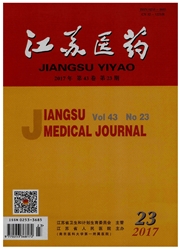

 中文摘要:
中文摘要:
目的探讨血管内皮生长因子(VEGF)评估急性心肌梗死(AMI)的价值。方法测定AMI患者(A组,61例)和心绞痛患者(B组,20例)外周血VEGF表达,分析VEGF表达差异的临床意义。结果 A组外周血VEGF水平高于B组[(73.44±17.09)ng/ml vs.(58.79±36.43)ng/ml)](P〈0.05)。A组患者不同罪犯血管(前降支、回旋支、右冠脉)患者的外周血VEGF表达差异有统计学意义(P〈0.05)。随访18个月后,A组低VEGF(〈50ng/ml)患者的主要心血管不良事件(MACE)发生率高于高VEGF(≥50ng/ml)者(68.4%vs.22.2%)(P〈0.05)。结论在AMI早期阶段,外周血中VEGF有重要的生理作用;AMI早期低VEGF水平可作为临床上MACE的预测指标。
 英文摘要:
英文摘要:
Objective To investigate the clinical significance of the expression of vascular endothelial growth factor (VEGF) in evaluating acute myocardial infarction (AMI). Methods The expressions of VEGF in peripheral blood were detected in the patients with AMI(group A, 61 cases) and those with angina pectoris(group B, 20 cases). The significance of VEGF defferential expression was analyzed. Results The VEGF expression of peripheral blood in group A was higher than that in group B[(73.44± 17.09) ng/ml vs. (58. 79± 36.43) ng/ml] (P〈0. 05). VEGF expression level in different culprit vessels in group A was significantly different (P〈0. 05). The patients were followed up for 18 months, which showed that the incidence of major cardiovascular risk events(MACE) in group A was higher in the patients with VEGF 〈50 ng/ml in peripheral venous blood than those with VEGF ≥50 ng/ml(68. 4%vs. 22. 2%)(P〈0. 05). Conclusion In the early phase of AMI, intravenous VEGF has an important physiological function and low intravenous VEGF expression may be used as a clinical predictor for the occurrence of MACE.
 同期刊论文项目
同期刊论文项目
 同项目期刊论文
同项目期刊论文
 Association of SNP Rs6903956 on Chromosome 6p24.1 with Angiographical Characteristics of Coronary At
Association of SNP Rs6903956 on Chromosome 6p24.1 with Angiographical Characteristics of Coronary At 期刊信息
期刊信息
